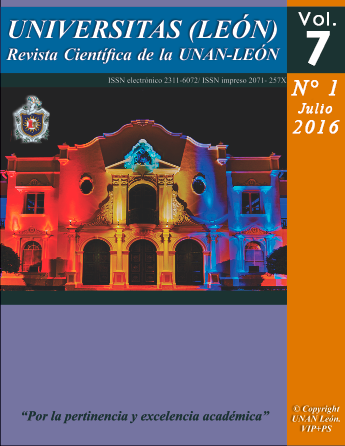Development of an alternative analytical method for the determination of the percentage of humidity and volatile matter in vegetable oil for edible use
DOI:
https://doi.org/10.5377/universitas.v7i1.13685Keywords:
Humidity, internal repeatability, analytical method, edible oilAbstract
A development study of an alternative analytical method for the determination of the percentage of humidity and volatile matter in vegetable oil for edible use was carried out based on the standards of the American Oil Chemists' Society (AOCS) Ca 2b-38 and the NMX-F -211-SCFI-2012. The method is based on the oven volatilization technique. Different heating times (0.5, 1, 1.5 and 2 hours), masses (5, 10, 15 and 20 g) and heating temperatures (96°C, 116°C and 125°C) were studied. The most optimal variables were selected: heating temperature at 116°C, heating time 1 hour and mass of 10 g to carry out the determination of humidity and volatile matter in samples of vegetable oil for edible use. The study was carried out on five brands of vegetable oils for edible use that are marketed in Nicaragua, in which I determine a percentage of humidity less than 0.1%, which is the limit established by CENTRAL AMERICAN TECHNICAL REGULATION (RTCA). It was concluded that the internal repeatability of four of the five brands of vegetable oil for edible use had% CV values of less than 8%. There are significant differences in the variances of each result group, finding high variability values for some samples.
Downloads
References
AOAC (1998). Peer-Verified Methods Program: Manual on Policies and Procedures, Arlington, VA .(pp-144) Recovery from http://www.aoac.org/vmeth/PVM.pdf
Bailey, Alton Edward (1961). Grasas y Aceites Industriales. Editorial Reverte Capitulo 23 pág. 616.ISBN 8429179011
Durán Agüero, Samuel, Torres García, Jairo, & Sanhueza Catalán, Julio. (2015). Frequently used vegetable oils in south america: features and properties. Nutrición Hospitalaria, 32(1), 11-19. https://dx.doi.org/10.3305/nh.2015.32.1.8874
Hartman, L., Jablonka, F.H. (1992). A modified moisture and volatile matter determination in fats and oils. Journal of the American Oil Chemist Society 69, 1276 https://doi.org/10.1007/BF02637702 https://doi.org/10.1007/BF02637702
NORMA TÉCNICA OBLIGATORIA NICARAGÜENSE. REGLAMENTO TÉCNICO CENTROAMERICANO (2011). Alimentos y Bebidas Procesados. Grasas y Aceites. Especificaciones. NTON 03 075-07/ RTCA 67.04.40:07 Gaceta no. 28-29, acápite 2.2 [Consulta 05 de mayo 2015]
MASSON, Lilia. (1997) Métodos Analíticos para la Determinación de Humedad, Alcoholes, Energía, Materia Grasa y Colesterol en Alimentos. Consulta FAO/OMS de expertos. DEPOSITO DE DOCUMENTOS DE LA FAO/Departamento de Agricultura. Capítulo 14 [Consulta 25 de mayo 2015] disponible en http://www.fao.org/docrep/010/ah833s/ah833s16.htm
NIELSEN, S. S. (2007) Análisis de Alimentos- Manual de Laboratorio. Purdue University West Lafayette, Indiana. Editorial Acribia. ISBN 84-0010-59-6
Norma Mexicana NMX-F-211-SCFI-2006. (2006). Alimentos -aceites y grasas vegetales o animales-determinación de humedad y materia volátil-método de prueba.http://www.colpos.mx/bancodenormas/nmexicanas/NMX-F-211-1987.PDF
Rivera, Y., Gutiérrez, C., Gómez, R., Matute, M., y Izaguirre, C. (2014). Cuantificación del deterioro de aceites vegetales usados en procesos de frituras en establecimientos ubicados en el Municipio Libertador del Estado Mérida. Ciencia e Ingeniería, 35(3), 157-164
Ordoñez, B. M., Moreno, L. C. C., Pérez, W. R., Murcia, M. A., y Alvarado, E. R. (2013). Caracterización de biodiesel obtenido de aceite residual de cocina. Revista Colombiana de Biotecnología, 15(1), 61-70. https://doi.org/10.15446/rev.colomb.biote.v15n2.35808
Downloads
Published
How to Cite
Issue
Section
License
Copyright (c) 2016 Array

This work is licensed under a Creative Commons Attribution-NonCommercial-ShareAlike 4.0 International License.
Copyright © 2025 Universitas (León), Revista Cientifíca de la UNAN-León. Academic Direction. Research Department. Publication and Scientific Event Unit.










